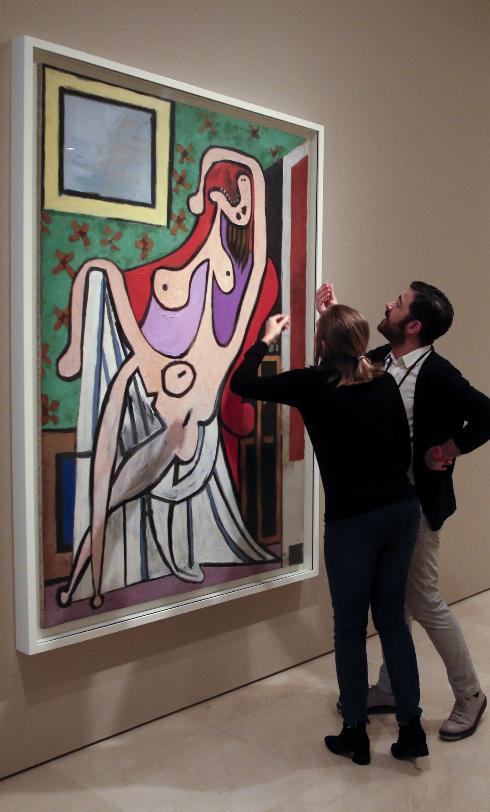

Secciones
Servicios
Destacamos

Antonio Javier López
Friday, 8 March 2019, 10:36
This is a long story. It begins with a travelling trunk, black with red trim, drawers inside, and looking pretty worn. Paul inherited this trunk together with the mansion in Boisgeloup when his mother died; it had been hers. Olga Khokhlova was Pablo Ruiz Picasso's first wife and the grandmother of Bernard Ruiz-Picasso, who on this bright afternoon is enjoying the sun in the courtyard of the Malaga Picasso Museum (MPM) as he talks about her, about the trunk, and the new exhibition at the museum.
"The trunk was the last thing Olga had, it was even with her in the clinic in the south of France where she died," explains Bernard, who is the president of the executive board at the MPM. "When they buried my grandmother, my father took the trunk to the house at Boisgeloup and there it remained, from the mid-1950s to now. After my father died, my mother told me there were some very important things in the trunk. When I was younger I wasn't particularly interested in that, and it was much later, when we created this museum with my mother, that we thought it would be a good time to see what was inside."
What they found inside the trunk was the start of 'Olga Picasso', the exhibition which is about to open at the MPM and will continue until 2 June. It has already been shown at the Picasso Museum in Paris and the Pushkin Museum, and when it ends in Malaga it will go on to the CaixaForum in Madrid.
"I didn't know much about my grandmother, and this project has helped me to learn more about her," says Bernard Ruiz-Picasso. A great deal of research had to be done before the exhibition could take place. "We have worked for over ten years on knowing more about Olga and her life with Picasso," he explains. The result is a collection of more than 350 pieces, ranging from the intimate to the artistic, the sentimental to the historical. "There is a certain consensus among specialists about calling this period of Picasso's work neoclassical, but I don't think it is exactly that," he says. At his side, the director of the MPM, José Lebrero, explains: "This exhibition suggests that some historical-artistic interpretations are, at least, questionable."
This is because 'Olga Picasso' is an exhibition "which can be read in different ways". A sentimental journey which also reflects a tragic part of the history of the 20th century during the couple's life together, as Bernard Ruiz-Picasso recalls: "The tragedy began from the start, because when Picasso met Olga in Rome in 1917 she was a dancer with the Russian ballet. Picasso totally changes focus and the whole artistic community thinks he has gone mad and no longer forms part of the avant-garde in Paris. And at almost the same time, there was the Civil War in Russia. So Olga rose socially beside Picasso and his artist friends, and at the same time she receives letters from her family who are living through the drama of the war. Her father disappeared, her two brothers were fighting on the front, but then they also disappeared."
Between intimacy and history
In this way, the exhibition 'Olga Picasso' is a reflection of European history but it is also an intimate history, especially when Picasso's new companion, Marie-Thérèse Walter, arrived on the scene at the end of the 1920s. Picasso didn't separate from Olga until 1935. For the last 20 years of her life, Olga resided in one hotel after another.
"Marie-Thérèse arrived around 1927 or 1928, and that had a direct influence on his work. You can see that in the exhibition. Olga wasn't stupid. She knew what Picasso was like. And in his works, Picasso presents himself as the reason for her pain."
Bernard Ruiz-Picasso picks up the catalogue for the exhibition and looks for the drawing called 'Minotauro cargando una yegua y su potro en un carro', from 5 April 1936: "Picasso is the minotaur pulling the carriage; that dead horse is my mother and the foal, there, is my father". And then Olga and Pablo's grandson spends a few silent minutes contemplating the drawing....
Coming out of his trance, he says: "Picasso kept these works with him until he died. He was never separated from them. I think it was a type of private diary which enabled him to continue his creative introspection."
That open diary can now be seen at the Picasso Museum in Malaga, which almost more than ever before is living up to its vocation as a "family museum".
Publicidad
Publicidad
Publicidad
Publicidad
Esta funcionalidad es exclusiva para registrados.
Reporta un error en esta noticia

Debido a un error no hemos podido dar de alta tu suscripción.
Por favor, ponte en contacto con Atención al Cliente.

¡Bienvenido a SURINENGLISH!

Tu suscripción con Google se ha realizado correctamente, pero ya tenías otra suscripción activa en SURINENGLISH.
Déjanos tus datos y nos pondremos en contacto contigo para analizar tu caso

¡Tu suscripción con Google se ha realizado correctamente!
La compra se ha asociado al siguiente email
Comentar es una ventaja exclusiva para registrados
¿Ya eres registrado?
Inicia sesiónNecesitas ser suscriptor para poder votar.